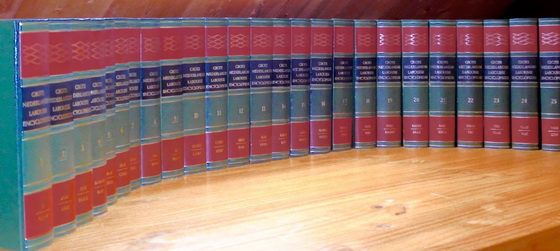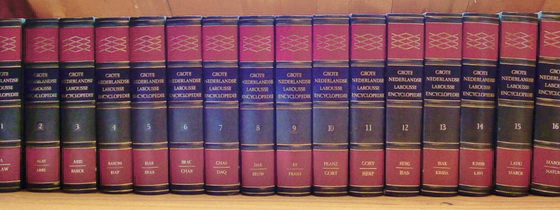Article 15: Visit E-bay and buy yourself a 25 volumes Encyclopedia.
They cost almost nothing; nobody wants them, because nowadays we have Wikipedia. I bought myself a beautiful 1979 edition for 25 euro and, of course, all the volumes look like new, because after having been purchased at that time by responsible parents to educate their three children, they haven’t been used too often.

No, don’t worry, you don’t have to read them, but you can use them as an instrument, as a tool to comprehend a little bit better, or at least to visualize a history of 13,750 million or 13.75 billion years, the Big History from the Big Bang to the Present, to us, human beings, to me and to you.
For practical reasons, let us agree on the following details:
We have 25 volumes, each volume contains 550 pages, each page has 40 lines and each line has 70 letters. This gives us the following results:
| Each volume describes 13,750 : 25 = | 550 million years |
| Each page describes 550 : 550 = | 1 million years |
| Each sentence describes 1,000,000 : 40 = | 25,000 years |
| Each letter describes 25,000 : 70 = 357, let’s say | 350 years |
Now, what is happening in each of our 25 volumes?
Where do we find the landmarks of our common history? When did the first stars shine? Where do we find the genesis of our Milky Way, of our Solar System, of our Earth and our Moon? Where do we find the first signs of Life on Earth? When came the first fishes into existence, the first terrestrial animals, the first trees, birds, horses, fruit trees and us, homo sapiens? Where do we find Buddha being born, Darwin travelling on the Beagle, Einstein figuring out his E = Mc2?
And on which page are we mentioned, our grandfather, our mother, me and you and our children? Let’s have a closer look and give ourselves a chance to get a glimpse of what a Big History looks like.

Volume 1, first page, the very first letter: The Big Bang, the start or our journey through deep time and deep space, immediately followed, on line 6, by the cooling down, just like we do when we are hot. Still on the very first page we find the formation of protons, neutrons and electrons and somewhat later the formation of atoms, in particular hydrogen, helium and a touch of lithium, the elements 1, 2 and 3 in our periodic table…. What has happened since then? The force of the Big Bang scatters energy and matter apart and gravity drags them together again, just like our own heart does: expansion and contraction.
On page 100 the first stars start to shine and on page 250 the first galaxies come into existence. Nowadays we estimate the number of galaxies at 100 billion and each galaxy at 100 billion stars.
Volume 2: In an ongoing process more and more galaxies are formed. In the January issue of the 2013 Astrophysical Journal Letters an international group of astronomers, using the Hubble Space Telescope, reports about the discovery, in the Hubble Ultra Deep Field in the constellation Oven, of 7 new, extremely distant galaxies from the time that the universe was ‘only’ 360 to 600 million years old.
Volume 3: The formation of our own galaxy, the Milky Way, named after the milk from the breasts of the Greek goddess Hera.
Volumes 4, 5, 6, 7, 8, 9, 10, 11 and 12, which means from 12,100 million until 7,150 million years ago, contain together a period of 4,950 million years, longer than the existence of the Earth. They tell us numerous stories about so many births, lives and deaths of so many stars. Stars are an integral part of an ongoing creative process, they are co-creators. Dependent on their size, they can reach such high temperatures on their deathbed, that they are able to cook the heavier elements.The moment they die they explode in a supernova, throwing their enriched ashes into the universe. A next generation of stars will be much richer in elements, because they will profit from this legacy they have got for free.
Volume 13, page 275: We are halfway, just in between Then and Now.
Volumes 14, 15, 16, more and more births and lives and deaths of stars, a universe becoming richer and richer in elements… and there is our planet!

 Shanti is a regular contributor to Osho News
Shanti is a regular contributor to Osho News
All essays of this series can be found in: At Home in the Universe
All articles by this author on Osho News.




Comments are closed.